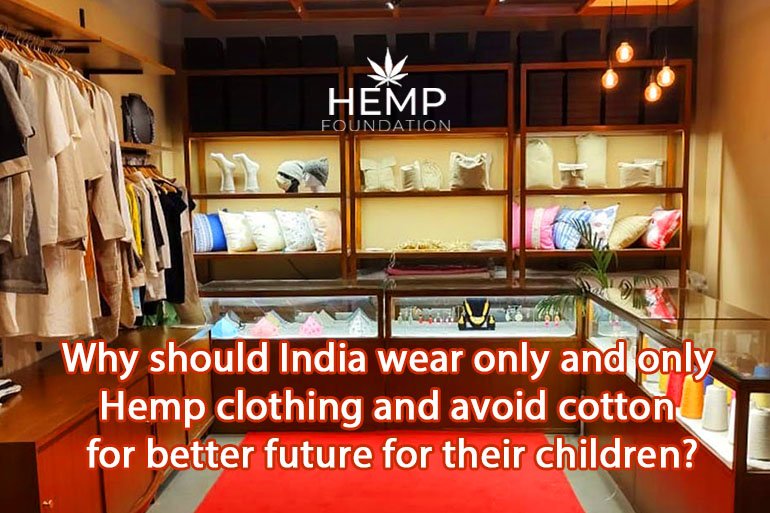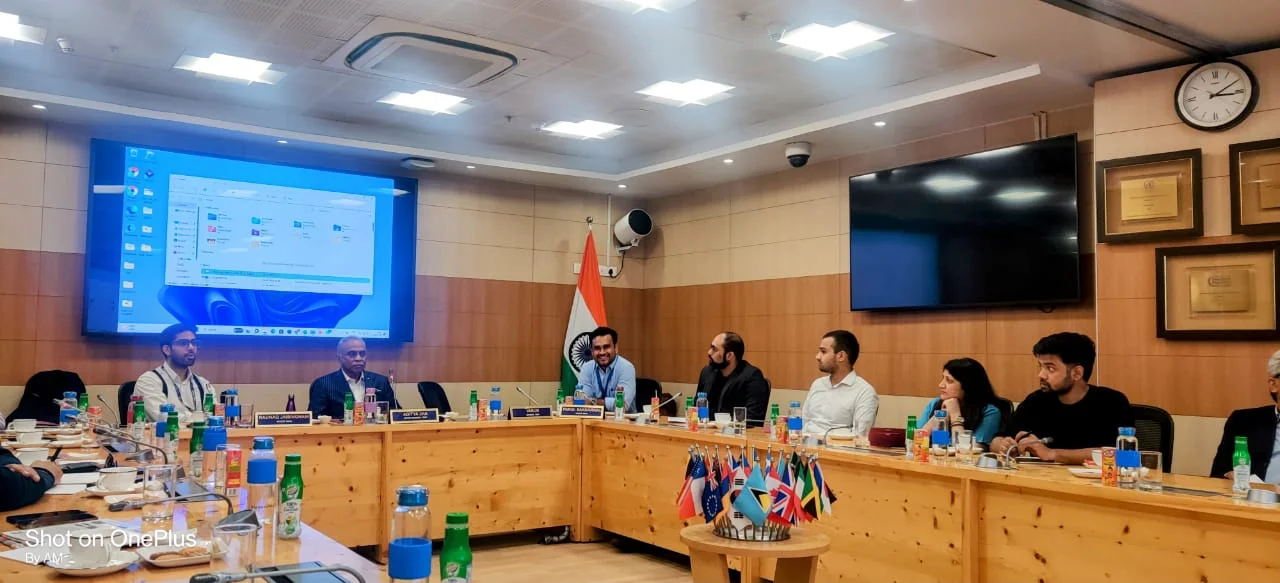Why should India wear only and only Hemp clothing and avoid cotton for better future for their children?
Cotton is a widely popular fabric crop in India and also plays a vital role in its export economy. However, the crop has its large share of issues as well – in terms of environment and negative impact on agricultural community. These “cons” are generally glossed over or covered by the inflated list of “pros”- either intentionally or due to a popular public notion.
In contrast to it, there is comparatively limited positive literature available on Hemp fabric, which is far superior to cotton in many aspects, especially when talking in the context of India, its farmers, and its future. Climate change is real and economic disparities between haves and have-nots, urban and rural, farmers and industrial buyers are fast increasing.
Let us discuss some of the major points proving that if we want to leave a better India for our children as well as the coming generations, it is the high time we should start replacing cotton fabric with hemp fabric
Hemp fabric can reduce water scarcity in India
Won’t you like to leave for our children a country which if devoid of the water issues today? India is struggling with an acute shortage of water. The country houses around 17.7% of the global population that has to manage their life with a meager share of just 4% of the world’s freshwater.
Lack of water means a less cultivated area that translates to lower-income which affects the economic and family life of an entire household. Moreover, it is projected that by 2030 the availability of water in India will be just 50% of the demand, a situation that will become worse with passing years. This is certainly not the legacy we wish to leave for our generations.
Now compare the above scenario with this. It takes a whopping 2,700 liters of water to produce just a single cotton T-Shirt that many of us might be wearing now. Two thousand seven hundred liters of water just for a single T-Shirt. The cost is massively high. It is because cotton is a very thirsty crop.
When compared to cotton Hemp requires just half the amount for farming which means that just by switching from cotton t-shirt to hemp t-shirt you can save more than 1000 liters of water- isn’t it a good service to the environment?
But it’s not only about the water. Cotton farming affects the environment in myriad ways.
Hemp farming uses negligible chemicals
Massive use of chemicals in the cotton industry is a major concern. During the farming period herbicides, pesticides and fertilizers are extensively used to boost production. While fabrication the chemicals are liberally employed in the retting process, dyeing, and other industrial processes.
Right from farm to factory cotton keeps on heavily increasing the carbon footprint. A significant amount of pesticides and insecticides are used throughout the entire tenure of cotton farming that affects the land, air, and ultimately the water where they finally get deposited. Along with threatening the marine population including some of the rarest species, such water may also compromise our health and the health of our coming generations.
The solution to this issue lies not in theoretical options like organic cotton that requires a significantly long time and complicated farming methods- something that is out of scope for the majority of Indian farmers. The practical solution is to look for democratic substitutes that are eco-friendly, farmer-friendly, and India-friendly. Hemp fabric can be the best solution to consider here.
Besides, Hemp requires nil or a negligible amount of pesticides. As opposed to cotton that degrades the quality of its surrounding soil, Hemp improves the soil quality by replenishing the natural nutrients. It also prevents soil erosion which is good for both farmers and the environment. What’s more, hemp grows significantly faster than cotton and offers more than twice the yield per acre. It simply means that the farmers would be able to gain more yield in a shorter period that will steadily enhance their economic condition and life quality of the dependents.
Many of you might be skeptical about the fiber quality for the consumers. The hemp has all the good qualities of cotton fiber- it allows your skin to breathe freely and also possesses potent antibacterial qualities. When compared to cotton the hemp fabric is extremely strong which means it has much more durability than cotton fabric. All these qualities make it the ideal fabric for consumers as well.
Hemp is an ideal crop for small farmers
Those who are still in two minds about how these qualities fare in the practical scenario, here’s good news- wearing hemp fabric isn’t just a novel idea but a time-tested fashion tradition. Till the first 2 decades of the last century, hemp fabric was the major material for producing clothes enjoying the same status as cotton of today. It simply means that Hemp clothing can easily be incorporated into popular culture.
Land is the prime investment element for any farmer and the soaring figures of real estate make it harder than ever for small farmers to own land. It leaves them with a significantly smaller capital for meeting running costs. They have to wisely choose the crops that offer maximum yield with very less inputs (pesticides, fertilizers, etc.).
When we compare cotton with hemp the latter enjoys a competitive edge over the former. Hemp needs just 50% of the water when compared to cotton. Moreover, it yields 3X the volume of cotton from each acre of land. It simply means that small farmers can expect higher profits from this crop. This high profitability will encourage more farmers to own land.
Hemp assures better “per-plant-income”
We have already discussed how hemp helps farmers by offering a significantly higher yield per acre when compared to the cotton plant. The things become all the more beneficial because it proactively helps the farmers to boost their “per-plant-income”.
A farmer can commercialize nearly all the major parts of a hemp plant which allows him to diversify the income options and boost the overall benefits. Right from flowers and leaves to the trunk different parts of a hemp plant can be used in diverse ways- fabric to food, medicines, and even fuel. Environmentally speaking, it allows us to fulfill our diverse needs from a single commercial plant which plays a significant role in eco-conservation efforts.
From the farmers’ point of view, it allows small and poor farmers to get the maximum returns out of each plant and diversify their commercial reach which positively influences their income and economic stature.
Hemp fabric’s positive role in eco-friendly start-up culture
Hemp Fabric can even encourage the nature-based start-up culture in India as start-ups can produce multiple hemp products at the same facility by investing only in additional machines. Moreover, the government proactively encourages the commercialization of sustainable, eco-friendly products that save natural, non-renewable resources. It involves subsidies, lower interest rates, better launching opportunities, and other preferential policies. Collectively, it can play a solid role in encouraging the Startup economy in India.
Hemp can help in bringing kids and their parents back to the deserted villages
India lives in villages; this statement still holds even after huge urbanization. However, the massive population movement drain from villages to cities is fast changing the scenario. A large number of villages- almost the entire villages have been deserted as the population move to cities due to lack of livelihood.
More surprisingly a large (collective) area of farms has been abandoned due to lack of resources like water and hostile climate issues like meager rainfall that fails the crops. It is deplorable that the farmers with their farms (even the small ones) are forced to find small or temporary jobs in cities- struggling to save meager amount after spending on their square meal and necessities. It hurts the very soul of India.
Sturdy crops like hemp have very less dependability when compared to other commercial crops like cotton. Even farmers with limited means and small land find it reasonably easier to start and sustain hemp farming as it requires less water, almost zero pesticides/insecticides, higher yield, and very high returns from different parts of each plant.
When planned and implemented strategically this move can help in both sustaining and encouraging Agripreneurship in villages and also helps in reinfusing life in deserted villages. In this way, hemp can also play a role in strengthening and revitalizing the villages of India.
Hemp isn’t dependent on artificial eco-damaging methods
Due to an ever-increasing demand the cotton industry has significantly increased the use of artificial methods during the last few decades. These artificial (read chemical) methods have a very deep, devastating, and long-term impact on the environment. Right from farming to fabrication, coloring, and bleaching- almost every phase of cotton production uses hazardous chemicals to speed up the process for quickly meeting the demands.
Azo dyes, formaldehyde, chlorine bleach, and benzidinecause- all these chemicals are as formidable as their names sound. Without going too deep into technical details it suffices to say that every phase of cotton production has a corresponding negative impact on our environment- increased carbon footprint, depleted natural resources, hazardous effects on marine lives, and indirect health hazards for human beings.
Hemp on the other hand uses almost zero chemicals while growing. Being a weed itself the hemp doesn’t need weed killers. As a natural pest repellent Hemp, there is almost no need for pesticides. Unlike cotton fabric, hemp is not over-commercialized which means there is no need for war-level production using “instant artificial methods” which include harmful chemicals.
Moreover, even the retting process has an eco-friendly mechanical option available (along with the conventional chemical process). It simply means that Hemp farming is chemical-free and when produced wisely, its production stage can also be kept almost free from chemicals.
Hemp can help farmers get better price in the market
Due to high demand and competition, the cotton’s prices have been reduced unreasonably forcing the production stakeholders to be satisfied with marginal profits. While the huge factories and production/retailing brands can easily find ways to recover the lost margin by high volume selling or exporting luxury labels at higher costs to foreign/institutional buyers, the small businesses and rural farmers are worst affected by the lower margins.
It has greatly impacted their income potential and also compelled them to take loans for somehow sustaining their agricultural practices; it is like a vicious cycle for many farmers.
Hemp can empower such farmers to come out of this cycle and steadily increase their income potential. Hemp fabric still has lower market competition which means the stakeholders can expect a fairly good market price for hemp fabric. Along with helping the small business units, it will also help small farmers to earn a good income. Moreover, due to its good quality, the hemp fabric of India can also have bright prospects when it comes to exporting to big consumer nations like the US. It will further strengthen the overall income opportunities in Hemp fabric.
Conclusion
Increasing concerns about climate change, widening carbon footprint issues with tangible impacts, and high effect on marine life has made it almost mandatory to replace the conventional commercial products with eco-friendly substitutes. For a large part of the last century (and even up till now) the consumerism has been harming the environment and this is the time to think about leaving a better planet for our kids and the next generations.
Talking in this context, we need an immediate substitute for one of the crops with a massive carbon footprint- Cotton. Hemp comes up as an ideal choice not only because it requires less comparatively resources and almost zeros chemicals but also because of its farmer-friendly profile that naturally aligns with the rural economy needs.





